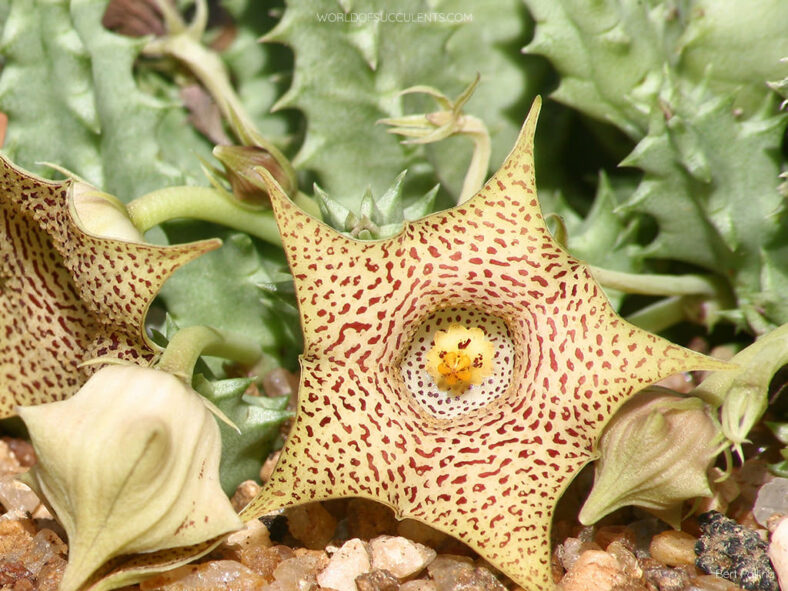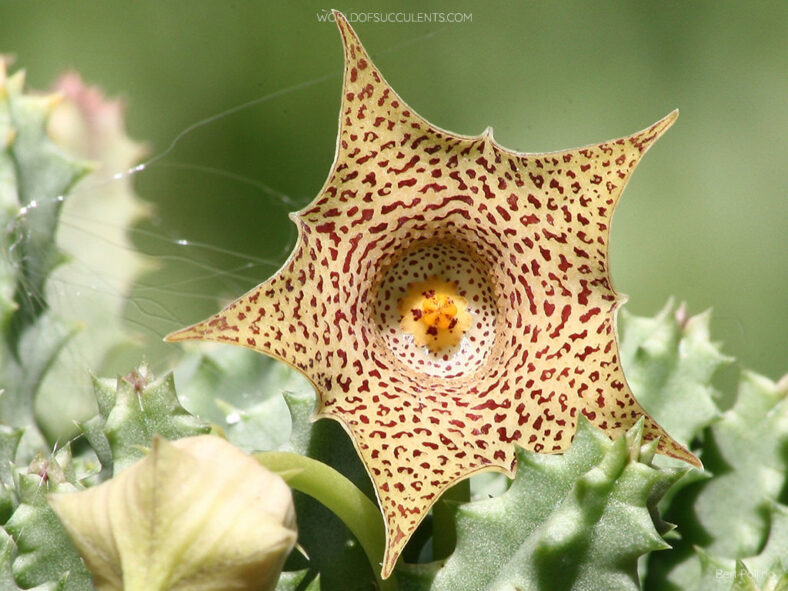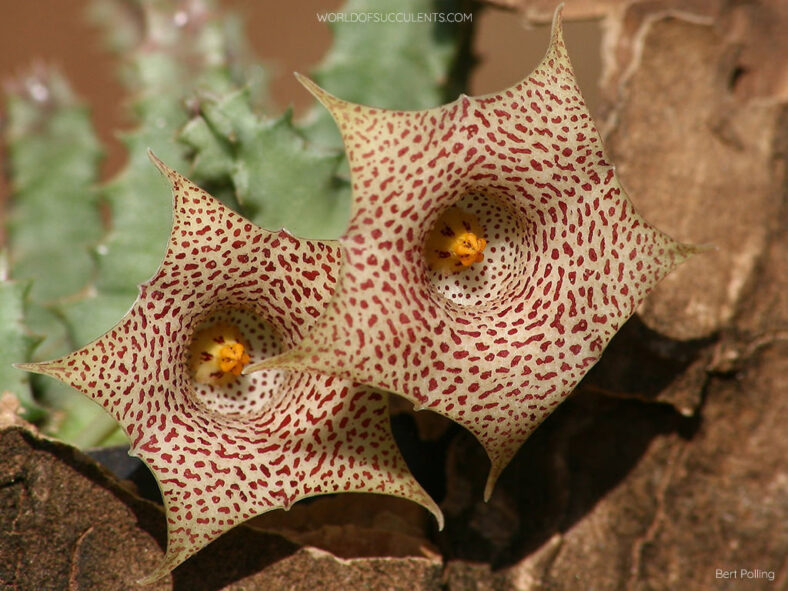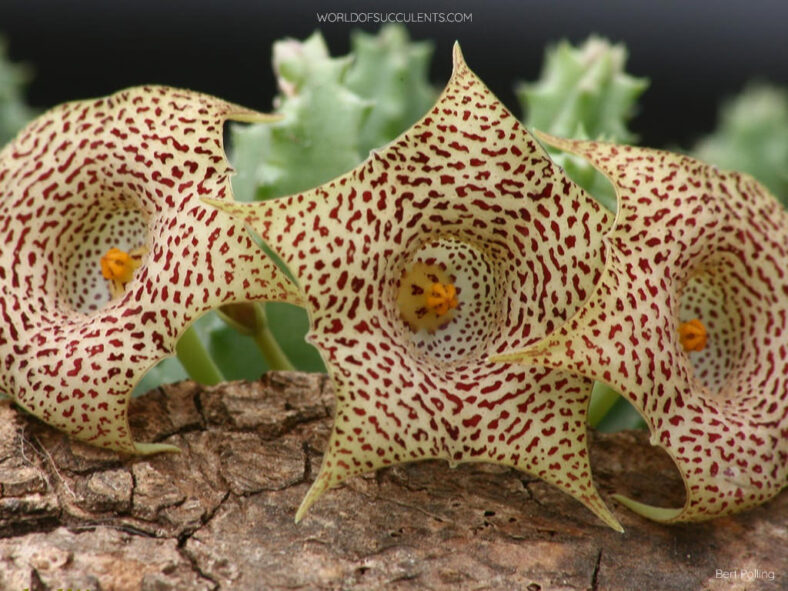Huernia hallii was first discovered by Harry Hall, who managed the succulent collection at Kirstenbosch National Botanical Garden in Cape Town, South Africa, from 1947 until his retirement in 1968. He found this species in 1955 among some quartz rocks on the flats near Grünau in Namibia.
Scientific Name
Huernia hallii E. & B.M.Lamb
Synonym(s)
Ceropegia hallii, Huernia namaquensis subsp. hallii
Scientific Classification
Family: Apocynaceae
Subfamily: Asclepiadoideae
Tribe: Stapeliae
Genus: Huernia
Etymology
The specific epithet "hallii" (pronounced "HALL-ee-eye") honors Harry Hall (1906-1986), a British-born South African horticulturist, botanist, and succulent plant authority who discovered this species.
Origin
Huernia hallii is native to southern Namibia. It grows on outcrops of dolomite or sandstones at altitudes ranging from 4,920 to 5,905 feet (1,500 to 1,800 m). Its distribution extends from near Aus southward to near Witpütz and in many of the higher regions of the Great Karas Mountains around Grünau.
Description
Huernia hallii is a dwarf succulent that forms dense clumps of decumbent, pale green stems, often with a faint reddish hue. The stems can grow up to 12 inches (30 cm) long and 0.4 inches (1 cm) thick. They have long, deltoid, spreading tubercles joined towards the base, forming 4 to 5 angles along the stem. The tubercles taper sharply into fine, acute tips.
In the fall, Huernia hallii produces 1 to 3 inflorescences per stem on stalks up to 0.6 inches (1.5 cm) long. Each inflorescence can develop 1 to 5 flowers in gradual succession. The bell-shaped flowers can reach a diameter of 1.5 inches (3.8 cm) and are held on stalks measuring up to 1 inch (2.5 cm) long.
On the outside, the corolla is smooth to somewhat irregularly roughened and ranges from cream to reddish. It has one heavy and 2 to 4 lighter raised longitudinal veins running down each lobe. The inside of the corolla is cream-colored, spotted, and irregularly lined with maroon to pink. The lower half of the tube is smooth, while the rest is covered with very low conical papillae. The corona has yellow to maroon outer lobes and yellow inner lobes.

How to Grow and Care for Huernia hallii
Light: Huernia hallii prefers bright light or partial shade during the hottest summer days. Too much sun can cause the stems to develop a protective pigmentation or get sunburned. Too little light leads to weak, thin stems and decreased flower production. When grown indoors, place the plant near the brightest window of your home.
Soil: The right soil is crucial to successful growing. Use a commercial potting soil mix for succulents, or prepare your own with 50 to 70 % mineral grit, such as coarse sand, pumice, or perlite.
Temperature: Huernia hallii thrives in warm outdoor environments with low to moderate humidity but does not like winter cold and should remain fairly dry and warm during its winter dormancy. It grows best in USDA Plant Hardiness Zones 10b to 11b, with average minimum winter temperatures ranging from 35 to 50 °F (1.7 to 10 °C).
Watering: This plant has typical watering needs for a succulent. During the growing season, water it thoroughly and allow the soil to dry between waterings. It goes dormant in winter and needs almost no water, about once a month.
Fertilizing: To keep it healthy and thriving, fertilizing during the growing season is a good idea. Feed with water-soluble fertilizer diluted to half the recommended strength.
Repotting: The plant will benefit from fresh potting soil every 2 or 3 years. Repot it in spring, just before the growing season. Pick a container with drainage holes.
Propagation: The best way to propagate Huernia hallii is by using stem cuttings. Take cuttings during the growing season to ensure good rooting. You can also start this plant from seeds, which is quite easy.
Learn more at How to Grow and Care for Huernia.
Toxicity of Huernia hallii
Huernia hallii has no toxic effects reported, so it is safe to grow around kids and pets.
Links
- Back to genus Huernia
- Succupedia: Browse succulents by Scientific Name, Common Name, Genus, Family, USDA Hardiness Zone, Origin, or cacti by Genus
Photo Gallery
Click on a photo to see a larger version.


